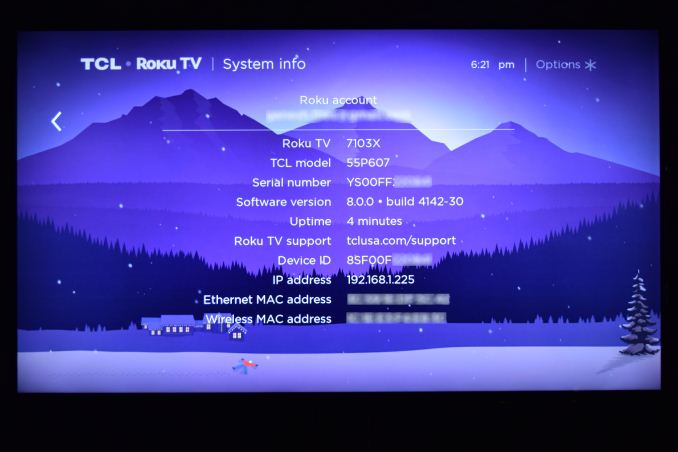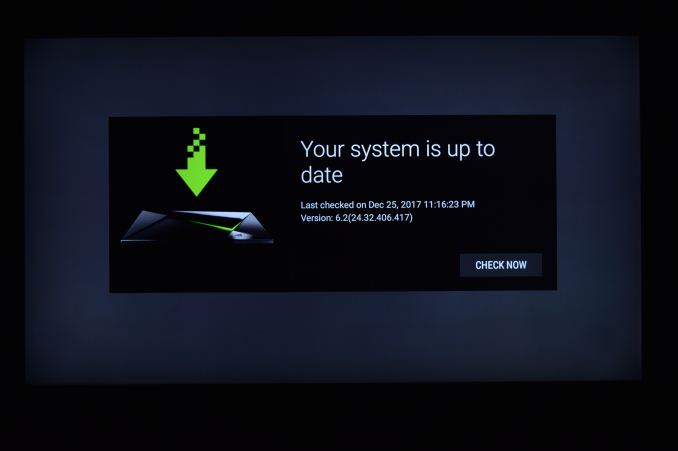A Budget Home Theater & PC Setup: 4K, HDR, UHD Blu-ray, and More
by Ganesh T S on December 26, 2017 8:30 AM ESTEvaluating Display Sources: HTPCs & CE Devices
Home Theater PCs used to be bulky versatile machines that had to support built-in TV tuners, a number of hard disks, as well as optical drives. However, the rising popularity of network TV tuners, network-attached storage (NAS) devices, and OTT streaming have resulted in the a transformation of the functionality that people expect from HTPCs. Simply put, a modern-day HTPC needs to be a flexible and versatile media player capable of handling a multitude of codecs and DRM requirements. The latter is not restricted to the handling of the encoded video. The display output also needs to be secure, while providing enough bandwidth and features to take full advantage of the capabilities of the downstream devices in the setup.
The average consumer often finds the 'it just works' nature of consumer electronic (CE) equipment such as the Roku streamers, game consoles, and standalone Blu-ray players to be attractive. However, for power users, the flexibility of HTPCs (such as the ability to support arcane subtitle formats or specific container features such as MKV chapters, or, even serve as a gaming machine) is simply too much to give up. Certain CE devices such as the NVIDIA SHIELD Android TV STB attempt to offer the best of both worlds. However, they are still closed platforms, and often do not have enough horsepower to fall back upon software decode for unsupported codecs.
Despite my predilection for HTPCs, I wanted to bring out the pros and cons of other closed solutions. Towards this, the evaluation of various options for media playback / display sources addresses the following aspects:
- HDR Support
- OTT Streaming (YouTube and Netflix)
- Local Media Playback (via USB)
- UHD Blu-ray Playback with HDR
The first candidate is the TCL 55P607's built-in Roku platform. Our tests were processed with the TV connected to the network using its wired 10 / 100 Mbps interface and Wi-Fi disabled. Firmware version 8.0.0 4142-30 was used.
The second solution in our evaluation set is one of the most popular Android TV STBs in the market - the NVIDIA SHIELD Android TV (SATV). Despite having launched back in 2015, the combination of high-end hardware and regular firmware updates have kept it at the top of the media player / Android TV STB market. Our tests were processed with the SHEILD connected to the network using its wired 1 Gbps interface and Wi-Fi disabled. Firmware version 6.2 was used.
The use of a RF remote / controller, combined with IP control using a smartphone app, mean that the SHIELD can be safely tucked away out of sight in a home theater setup.
Moving on to the HTPC front, we have three different PCs, with configurations and driver versions listed in the table below.
| Compact Home Theater PC Candidates - 2017 | |||
| PC | Zotac ZBOX MAGNUS EN1080K | ASRock Beebox-S 7200U | Intel NUC7i7BNHX1 |
| CPU | Intel Core i7-7700 | Intel Core i5-7200U | Intel Core i7-7567U |
| GPU | NVIDIA GTX 1080 (8GB GDDR5X) | Intel HD Graphics 620 | Intel Iris Graphics 650 |
| RAM | Corsair Vengeance 2x16GB DDR4-2667 SODIMM | Micron 16ATF1G64HZ 2x8GB DDR4-2133 SODIMM | Crucial Ballistix Sport LT 2x16GB DDR4-2400 SODIMM |
| Storage | Toshiba OCZ RD400 (512GB) | Kingston SSD Now V+ SNV325S2 (128GB) | Samsung SSD 840 EVO (500GB) + Intel Optane (16GB) |
| BIOS | 2K170814 | 1.73 | BNKBL357.86A.0054 |
| GPU Driver | 388.31 | 4877+ (beta) | 4877+ (beta) |
| Specifications | Zotac ZBOX MAGNUS EN1080K Specifications | ASRock Beebox-S 7200U Specifications | Intel NUC7i7BNHX1 Specifications |
| Pricing (NOT as configured) | USD 2000 (with 120GB SSD, 1TB HDD, 8GB RAM, and Windows 10) | USD 349 (Barebones) | USD 506 (Barebones) |
Note that we are using a beta driver from Intel that will be released to the public in January 2018. The reason behind the use of this driver will be apparent in our UHD Blu-ray Playback section.
Windows 10 Fall Creators Update was used as the OS for all the tests done using the above PCs. This version is critical for cutting-edge HTPC functionality, as it brings HDR desktop and media payback support into the stable release channel.













191 Comments
View All Comments
mikato - Thursday, January 18, 2018 - link
Great point, and I also agree... unless you want local storage for media content. Sure I guess the response would be to have a PC (when we had been leaving out the PC) or a NAS feed content with DLNA or whatever that is with Plex or Kodi over the network. But then you have quite a bit more than just whatever box or stick. And if you wanted to bring your content with you to a friend’s house, you couldn’t do that, when you might be able to pretty easily with one of the UCFF PCs with a disk in it. Plus I’ll add that would be able to play anything, when for instance you might not be able to play YouTube with your Amazon stick or play Amazon with your Google stick.We’re close, but not quite there yet. What is there does cover things enough for a lot of people though.
Duto - Friday, December 29, 2017 - link
A TCL TV set?, really? , unbelievable!rapster - Friday, December 29, 2017 - link
Thank you for your thoughtful review of some of the tricks, traps, and solutions of the 4K HDR space. As someone who recently had to deal with a few of the challenges you worked through I really appreciate it. Your recommendation of the NVIDIA Shield is especially well-considered and would have saved me a lot of time for my applications. The comments section here has some gold to be mined as well.As for budget: I paid twice as much for my receiver as the $999 one you recommended and still consider it to be a budget unit. Anybody who has been to a "real" media equipment store understands this. Sorry to be "that guy" on my first post here, but I might suggest it's time for some folks (cough ddriver) to leave mom's basement and that job at the mall and get out more.
ronraxxx - Friday, December 29, 2017 - link
THANK YOU - I was getting so triggered reading these comments. "Budget" is relative. A brand new Kia costs $10,000 - it's still a *budget* vehicle in the world of new cars. Real home theater equipment is expensive - the key word being "THEATER." If you want a true, immersive, theater-like experience it usually is very expensive. If you only have $1000 to spend on your home "theater" I hate to break it to you but the TV, soundbar, and Roku that fits your budget isn't really a theater at all, unless you're in a dorm room.Reflex - Friday, December 29, 2017 - link
This right here. People get hung up on the word Budget. If the author could do one thing differently IMO it would be to define what the actual price tiers he is using are. People could yell all they wanted about how a $500-2000 range for budget receives isn't 'budget' in their world, but at least they'd know the author's definition.Honestly the compromise he made in this that I wouldn't have is the TV. Nothing against TCL, but seriously if you are building a theater it seems like what you look at should be the number one priority. I spent about $3k in total on my setup (budget!) and $2k of that was the tv. There is also the consideration of space, in my case the space permitted isn't theater quality or size, so the 'budget' consideration is different as spending $10k on speakers would gain me nothing in the space allowed.
I'd like to see Anandtech cover this space. I like the practical approach they took here and the mostly plain language. I like how the final reccomendation list had options on most of the items so people could easily define their priorities. But if they do go forward they should define some basic terms like what is considered 'budget' for both individual components and for a total setup, and what kind of spaces they are trying to address (dedicated theater? living room? corner of a bedroom?). With that in place most of the arguments in this thread become pedantic noise.
Bullwinkle-J-Moose - Saturday, December 30, 2017 - link
" The comments section here has some gold to be mined as well."---------------------------------------------------------------------------------------
Well thank you for those kind words Rapster, and remember kids......
If you can't sing, you can always Rap!
FreckledTrout - Sunday, December 31, 2017 - link
I agree completely. I have about 2.5K into my home theater sound(not including anything not sound related) and I felt that was rather budget oriented. I did put about $700 into a SVS subwoofer which in my opinion is what makes or breaks most home theater builds.Lau_Tech - Friday, December 29, 2017 - link
Assuming the point of the article was to promote the receiver... Why not just focus on reviewing the receiver? Many sites have also compared htpc with Xbox and ps4s.. An article on that would have been useful as well.As it stands the article simply feels amateurish and unfocused. What article on setting up a home theater (budget or otherwise) focuses on the receiver and htpc at the cost of the cornerstone elements:TV and speakers?
I truly do not know why efforts were expended in this new, odd direction when other product reviews are in higher demand.
HStewart - Friday, December 29, 2017 - link
One thing I curious about is GPU support for UHD. It appears you need Intel 630 or higher in Kaby Lake or the Xbox. Note even thought Xbox has older generation CPU and GPU, Microsoft must have modified the GPU to support UHD 4k. My guess is both NVidia and AMD will follow suit next year.One things that this defunct is claims that Kaby Lake is no different than previous generations Intel processors. And unfortunately for me having older i7, it can't be claimed that Intel is just doing this for people to buy new cpus - since both NVidia and AMD don't support it.
The Jedi - Saturday, December 30, 2017 - link
Thanks Ganesh, good article. With a 4K Android TV and an Ultra HD Blu-Ray player, the HTPC's days are past. Me personally, I will keep my Windows Media Center HTPC for the DVR functionality, indefinitely.The standalone UHD Blu-Ray player is simpler, cheaper, and no-nonsense.
Android TV is something for services to rally around. Even with the security platform provided by Kaby Lake/Coffee Lake and Windows 10, services besides Netflix are not rushing to bring 4K to the PC.
A year ago I was so psyched about upgrading to a Kaby Lake i7 to be on the latest system and get onboard and support the PC 4K ecosystem. What impressed me was that Intel was working on overcoming the challenges that kept 4K discs and 4K services away from the PC. But, I decided I didn't really need it or Coffee Lake, and it was cheaper to keep my investment in DDR3. I upgraded to a Haswell Refresh instead.